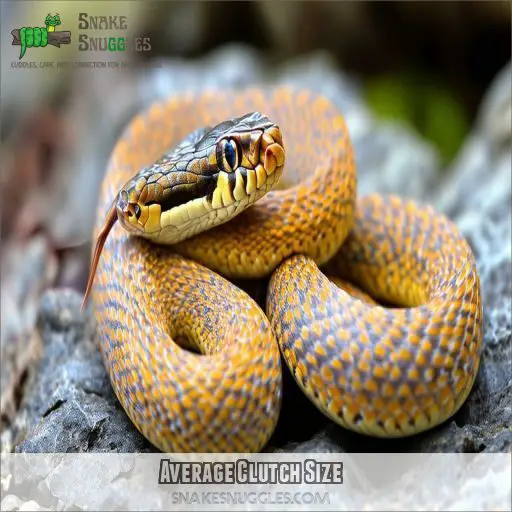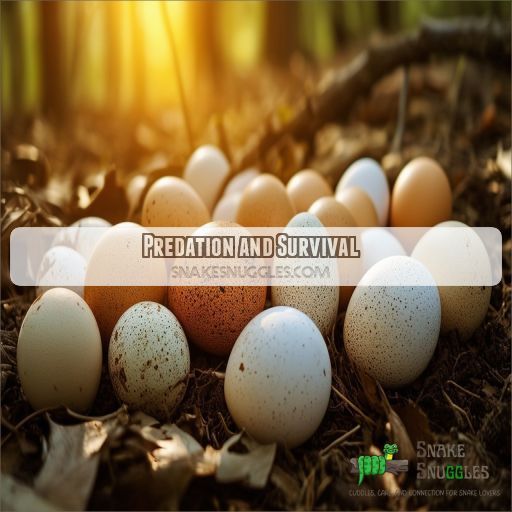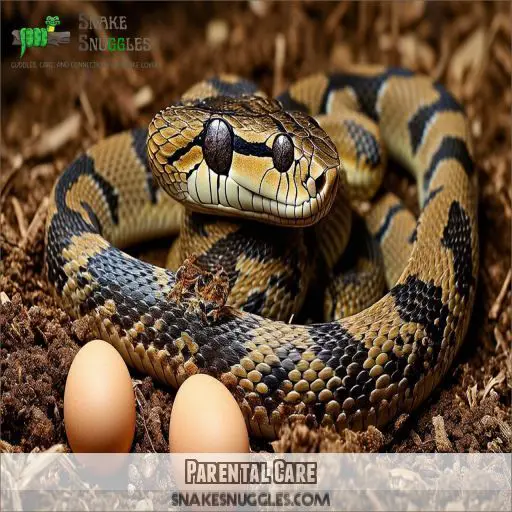This site is supported by our readers. We may earn a commission, at no cost to you, if you purchase through links.
 You’ll be amazed to learn that snakes can lay anywhere from 3 to 100 eggs per clutch, with survival rates varying dramatically based on species and environmental factors. Most snakes lay between 20-100 eggs, but some, like ball pythons, only produce 3-14. Larger snakes typically lay more eggs.
You’ll be amazed to learn that snakes can lay anywhere from 3 to 100 eggs per clutch, with survival rates varying dramatically based on species and environmental factors. Most snakes lay between 20-100 eggs, but some, like ball pythons, only produce 3-14. Larger snakes typically lay more eggs.
The incubation period lasts 2-3 months, with temperature and humidity playing important roles in successful hatching. On average, about 75% of eggs in a clutch of 10 will hatch.
However, newly hatched snakes face high predation rates, and only a small percentage reach adulthood. The journey from egg to adult snake is a fascinating tale of survival against the odds.
Table Of Contents
- Key Takeaways
- How Many Eggs Do Snakes Lay and How Many Survive?
- Average Clutch Size
- Factors Affecting Clutch Size
- Egg Incubation
- Hatch Rate
- Predation and Survival
- Parental Care
- Reproductive Strategies
- Conservation Concerns
- Frequently Asked Questions (FAQs)
- How many eggs can 1 snake lay?
- How many babies do snakes have at once?
- How long do baby snakes stay with their mother?
- Do snakes lay eggs or have live births?
- How do snake eggs differ from bird eggs?
- Can snakes lay unfertilized eggs like chickens?
- Do male snakes play any role after mating?
- How long can snake eggs survive without incubation?
- Are snake eggs edible for humans?
- Conclusion
Key Takeaways
- Snakes are the overachievers of the reptile world when it comes to egg-laying, producing anywhere from a measly 3 to a whopping 100 eggs per clutch. Talk about playing the numbers game!
- Mother Nature doesn’t play favorites – only about 75% of eggs in a typical clutch of 10 will hatch. It’s like snake roulette, with some eggs hitting the jackpot while others don’t make it past "Go."
- If you thought human teenagers had it rough, spare a thought for baby snakes. These little guys face a gauntlet of predators right out of the gate, with only a small fraction surviving to adulthood. It’s a snake-eat-snake world out there!
- Size matters in the snake world – larger species tend to lay more eggs. It’s like they’re following the "go big or go home" philosophy when it comes to reproduction.
How Many Eggs Do Snakes Lay and How Many Survive?
Snakes can lay between 6 to 100 eggs per clutch, with averages varying by species and size (Source). However, only a small percentage of these hatchlings, typically less than 10%, survive to adulthood due to high predation rates and environmental factors (Source).
Average Clutch Size
You’ll find that snakes typically lay between 20-100 eggs per clutch, though the exact number varies by species. The average clutch size depends on factors like the snake’s size, environmental conditions, and reproductive strategies.
Snakes Typically Lay Between 20-100 Eggs Per Clutch
You’ll be fascinated to learn that snakes typically lay between 20-100 eggs per clutch. This wide range reflects the incredible diversity of serpentine reproduction. Here’s what you need to know about snake egg-laying:
- Egg protection is essential for survival
- Clutch dispersion helps avoid predation
- Nest site selection impacts egg viability
Understanding these factors gives you insight into the complex world of snake reproduction. Incubation, hatching, and survival rates all hinge on these initial conditions.
The Average Clutch Size Varies by Species
While snakes generally lay 20-100 eggs, the average clutch size varies notably by species. You’ll find that factors like size, habitat, and evolutionary adaptations play key roles. Let’s break it down:
| Species | Average Clutch Size |
|---|---|
| Ball Python | 3-14 eggs |
| Corn Snake | 10-30 eggs |
| King Cobra | 20-40 eggs |
| Green Anaconda | 20-40 eggs |
| Burmese Python | 50-100 eggs |
Environmental influences and reproductive strategies shape these numbers, with conservation implications becoming increasingly important as climate change impacts snake populations worldwide.
Factors Affecting Clutch Size
You’ll find that larger snake species generally produce more eggs in each clutch, with some laying over 100 eggs at a time. Environmental factors like temperature and humidity also play a significant role in determining clutch size, as these conditions can affect a snake’s ability to produce and nurture eggs.
Larger Snakes Tend to Lay More Eggs
You’ll find that larger snake species generally produce more eggs per clutch. It’s a matter of scale – bigger snakes have more room for egg development.
For instance, anacondas can lay up to 80 eggs at once, while smaller corn snakes typically produce 10-30.
This variation in clutch size is closely tied to the snake’s body size, affecting its reproductive capacity.
Environmental Conditions Like Temperature and Humidity Impact Egg Production
Environmental conditions play a vital role in snake egg production. Temperature and humidity are essential in this process.
For ball pythons, maintaining a comfortable 86°F with high humidity is key for successful incubation. These factors influence not only clutch size but also hatch rates.
Misconceptions about snake parental care often neglect the precise regulation of nests, whether in houses or natural habitats.
Egg Incubation
Egg-laying snakes typically incubate their eggs for a period of 2-3 months, during which time the temperature must be carefully maintained. The incubation temperature is critical for successful hatching, as it affects the development and survival of the embryos inside the eggs.
Egg-laying Snakes Incubate Their Eggs for 2-3 Months
You’ll find that egg-laying snakes are dedicated parents, incubating their clutches for 2-3 months. These reptiles carefully select laying sites that offer protection and ideal conditions.
Egg sizes and colors vary by species, with some snakes producing small, white eggs while others lay larger, mottled ones. Candling can reveal embryo development, but handling should be minimal.
Nests are essential for survival, as they shield eggs from predators and environmental challenges.
Incubation Temperature is Critical for Successful Hatching
After the 2-3 month incubation period, temperature becomes critical for successful hatching. Egg development depends heavily on maintaining ideal humidity and temperature control.
Maternal behavior plays a key role, as snake mothers carefully regulate their eggs’ environment.
Getting these conditions right will result in higher survival rates. It’s a delicate balance – if it’s too hot or cold, the young snakes won’t make it out of their shells.
Hatch Rate
You’ll find that hatch rates in snakes vary widely depending on species and environmental conditions. For clutches of around 10 eggs, you can expect an average hatch rate of 75%, but proper incubation techniques are essential for maximizing the number of successful hatchlings.
Hatch Rates Vary Depending on Species and Environmental Factors
You’ll find that hatch rates in snakes are as diverse as the species themselves. Environmental factors play a key role in determining success. Here’s what influences hatch rates:
- Temperature fluctuations during incubation
- Humidity levels in the nest
- Genetic health of the parents
Clutch size, incubation conditions, and predation rates all factor into the equation. Remember, Mother Nature’s a wild card – even with perfect conditions, some eggs just won’t make it.
Clutches of 10 Eggs Have an Average Hatch Rate of 75%
You’ll find that snake clutches of 10 eggs typically achieve a 75% hatch rate. This means out of every 10 eggs laid, about 7 or 8 will successfully hatch. Let’s break down some key factors influencing hatch rates:
| Factor | Impact | Example |
|---|---|---|
| Species | Varies | Ball pythons: 80-90% |
| Temperature | Critical | 88-90°F most favorable |
| Humidity | Essential | 70-80% ideal |
| Egg quality | Crucial | Healthy female = better eggs |
Proper Incubation is Key to Maximizing Hatch Rates
To maximize hatch rates, you’ll need to nail the incubation process. Keep egg humidity high and maintain consistent temperatures throughout the incubation duration.
Choose the right substrate material to support the eggs and mimic natural conditions.
Predation and Survival
You might be surprised to learn that newly hatched snakes face incredibly high predation rates. Only a small percentage of these vulnerable hatchlings survive to reach adulthood, highlighting the challenges young snakes encounter in their early stages of life.
Newly Hatched Snakes Face High Predation Rates
After hatching, young snakes face a perilous world. You’ll find these hatchlings are incredibly vulnerable, with predators lurking at every turn. Egg protection strategies only go so far once they’re out in the open. Here’s what these tiny reptiles are up against:
- Sharp-eyed hawks circling overhead
- Sneaky raccoons prowling the underbrush
- Quick-footed rodents ready to pounce
- Larger snakes seeing an easy meal
Hatchlings must rely on predation avoidance behaviors and survival adaptations to make it through their first days.
Only a Small Percentage of Hatchlings Reach Adulthood
You’ll find that survival isn’t easy for baby snakes. After hatching, they’re on their own, facing a world of predators. Birds, mammals, and even other reptiles see them as an easy meal.
Oviparity and ovoviviparity strategies evolved to boost survival, but the odds are still stacked against them. Incubation temperature and hatch rate play a role, but even with proper hatchling care, risks abound.
Only a lucky few make it to adulthood.
Parental Care
Regarding parental care, most snake species adopt a detached approach. Surprisingly, hatchling independence is the norm in the serpentine realm. After snakes lay their eggs, they typically depart, leaving their offspring to fend for themselves. However, certain species do exhibit parental behavior:
- Ball pythons coil around their eggs for protection and temperature regulation
- King cobras construct nests and guard their eggs until hatching
- Pit vipers remain with their young for several days following birth
- African rock pythons have been observed defending their hatchlings
Despite these exceptions, most snake hatchlings are independent from birth. They possess the necessary survival skills, having absorbed their yolk sacs before emerging from their eggs. This self-sufficiency is essential, as offspring survival rates are typically low due to predation and environmental challenges.
Reproductive Strategies
You’ll find that snakes have evolved diverse reproductive strategies to guarantee their offspring’s survival. Some species lay eggs, while others give birth to live young. Regarding egg-laying snakes, you’ll notice variations in egg size, shape, and color across different species. For instance, you might encounter small, oval-shaped eggs or larger, more elongated ones. The color can range from white to off-white or even yellowish.
Temperature and humidity play essential roles in egg development. You’ll need to maintain specific conditions for successful incubation. Most snake eggs require temperatures between 80-90°F and humidity levels of 70-100%. Interestingly, temperature can also determine the sex of the offspring in some species.
Conservation Concerns
You’ll find that habitat loss and human-snake conflicts pose significant threats to snake populations worldwide. Conservation efforts are essential to protect these reptiles and their habitats, ensuring the survival of diverse snake species for future generations.
Habitat Loss and Human-snake Conflicts Threaten Snake Populations
While snakes have diverse reproductive strategies, they face growing threats. Habitat loss and human conflicts are taking a toll on snake populations worldwide.
As urban areas expand, you’re more likely to encounter snakes in your backyard, leading to misunderstandings and fear. This often results in unnecessary snake deaths.
Understanding the vital role of these creatures in ecosystems is essential for their survival.
Conservation Efforts Aim to Protect Snakes and Their Habitats
You’ll be pleased to know that conservation efforts are in full swing to protect snakes and their habitats. These initiatives focus on maintaining population dynamics and genetic diversity through habitat connectivity.
Conservationists are working to guarantee prey availability and mitigate temperature effects on snake populations. By preserving natural areas and educating the public, we’re giving these often misunderstood creatures a fair shot.
Frequently Asked Questions (FAQs)
How many eggs can 1 snake lay?
You’ll find that snake egg-laying varies widely. Some species lay just a few, while others can produce over 100 eggs in one clutch. On average, you’re looking at 10-30 eggs per snake, depending on the species.
How many babies do snakes have at once?
You’ll find snakes can have quite a range of babies at once. On average, they’ll produce 11 live young or 7 eggs per clutch. Some species, like water snakes, can even have over 100 offspring!
How long do baby snakes stay with their mother?
Like a protective shield, most snake mothers don’t stay with their young. You’ll find that after laying eggs or giving birth, they quickly depart. Baby snakes are independent from day one, relying on instincts to survive.
Do snakes lay eggs or have live births?
Snakes exhibit both egg-laying and live birth strategies. You’ll find most species lay eggs, while others give birth to live young. This diversity in reproduction helps snakes adapt to various environments and survival challenges.
How do snake eggs differ from bird eggs?
You’ll notice snake eggs are softer and more leathery than bird eggs. They’re usually oblong, not oval, and lack the hard calcium shell. Snake eggs are also typically larger relative to the mother’s size.
Can snakes lay unfertilized eggs like chickens?
Ever wondered about snake egg mysteries? You might be surprised to learn that some snakes can indeed lay unfertilized eggs. It’s not common, but certain species, like ball pythons, occasionally produce infertile eggs without mating, similar to chickens.
Do male snakes play any role after mating?
After mating, most male snakes don’t stick around. You’ll rarely see them involved in parenting. They’ve done their part by fertilizing the eggs, leaving the female to handle incubation and protection of the clutch.
How long can snake eggs survive without incubation?
You’d be surprised how resilient snake eggs can be. Without proper incubation, they’ll typically survive 24-48 hours. However, the clock’s ticking! Beyond that, their chances of hatching plummet dramatically. Every moment counts in this delicate dance of life.
Are snake eggs edible for humans?
While some snake eggs are edible, it’s not recommended for humans. They’re often small, with tough shells and little nutritional value. You’d need to cook them thoroughly to avoid potential parasites. It’s best to leave them for wildlife.
Conclusion
Like Odysseus traversing treacherous waters, snakes embark on a perilous journey from egg to adulthood.
You’ve learned that snakes lay anywhere from 3 to 100 eggs, with survival rates varying dramatically. While about 75% of eggs in a clutch may hatch, only a small fraction of hatchlings reach maturity due to predation and environmental challenges.
Understanding how many eggs snakes lay and how many survive is essential for conservation efforts. By protecting snake habitats and reducing human-snake conflicts, we can help guarantee the survival of these fascinating creatures.














